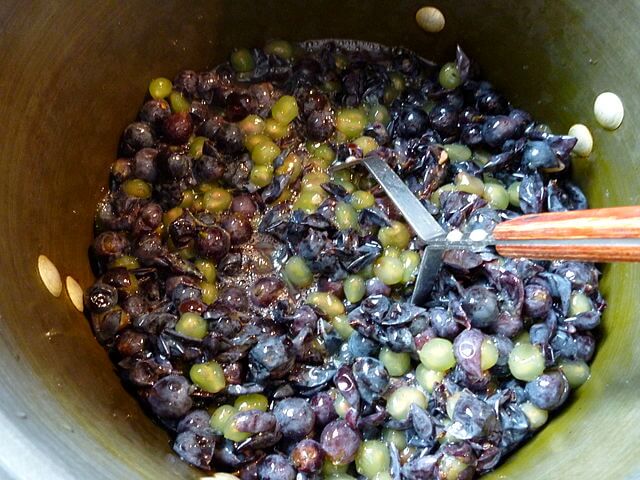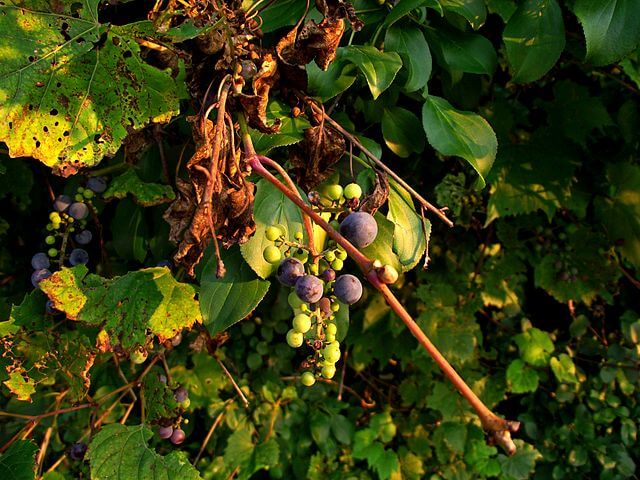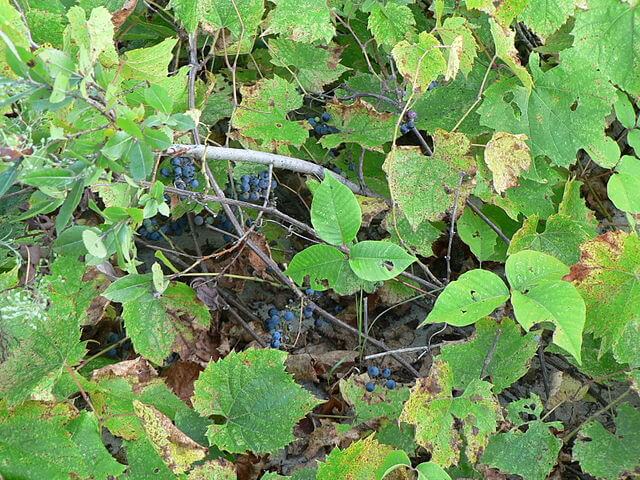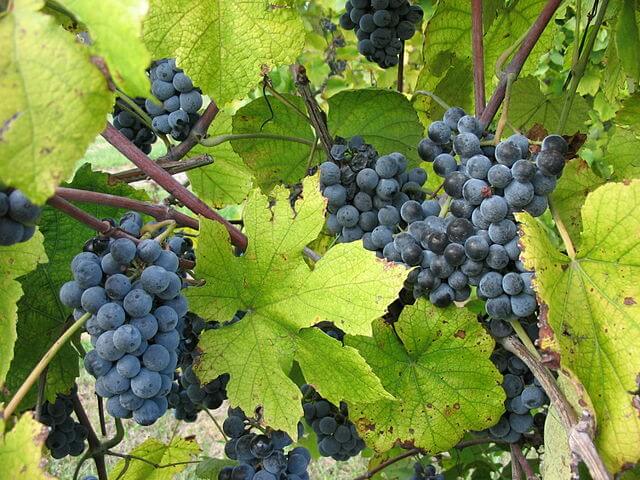The link between humans and wild grapes in North America is richly interesting. As a plant, their characteristics differ to the popular wine grape varieties grown within Europe. But they have a lot to offer, they’re edible, and are already widely used within a few popular products. For example Concord jelly, often used in the classic PB and J sandwiches! Like many cultivated fruits, wild grape plants within the US were foraged before eventually being cultivated and domesticated.

Is there a difference between Wild and Domestic Grapes?
When we think of grapes we tend to picture rows of neatly arranged vines within a vineyard, ready to be harvested. Their wild counterparts however, meander along riverbanks and climb trees at the edge of woodland clearings. Their long, leafy vines producing bunches of deep purple berries, or grapes, in late summer.
The majority of cultivated grapes around the world (used as wine and eating grapes), are mainly European varieties. They can be linked back to a wild grape species know as Vitis vinifera subsp. sylvestris. This species emerged within the mediterranean, and southwest Asia, and is responsible for almost all popular wines. Like Cabernet Sauvignon and Pinot Noir.

The main difference, is that wild grapes generally have either male or female flowers, never both. Whereas the domesticated Vitis vinifera has both male and female flowers, meaning wind or animal pollination is not necessary, and the plant is self-fruitful. This ensures a greater yield when it’s time for farmers to harvest the grapes, as every flower should self fertilize.
Amazing North American Native Grapes
There are plenty of amazing grape species that grow natively in the wild within North America. Some of the most well known species include the Fox Grape (Vitis labrusca), Summer Grape (Vitis aestivalis), Riverbank Grape (Vitis riparia), and Frost Grape (Vitis vulpina).
Grapes that originate in North America tend to have a slightly thicker skin, which is often called a ‘slip skin’. This is because the skin is easily removed from the flesh beneath. This tends to make them less suitable as a table grape, but great for creating juices, jams and jelly. You can read more about the different species and their usage here.

The Native Wine Grapes of America
Whilst many European varieties dominate the wine market, there is an emerging revival of American grape species. Wines such as Zinfandel and Sauvignon blanc are known across the world for producing a particular type of flavoring and wine. But there is great potential in native American grapes that is still largely unexplored. One emerging American grape variety is known as ‘Norton’. It produces a tasty red wine and is made using a hybrid of the American Summer Grape (Vitis aestivalis).
The Importance of Wild Grapes to Native Americans
Wild grapes were once a common food source for native Americans. The Fox and Riverbank grape were both commonly harvested for consumption. There are also records of the wild fruits and their leaves being used for medicinal purposes too.
The Arrival of European Grape Vines
Very early colonizers made notes about the amazing abundance of native wild grapes when they first set foot in North America. There are even records of the very first Europeans (Vikings) who first arrived in North America christening the area they landed as ‘Vinland’. Which hinted at the profusion of grapes they found.
Later European colonizers, who arrived in the 17th century, also noticed this. Recognising that Native Americans used the wild grapes as a food source, European colonizers also turned to them, and began producing wines and other produce.

Soon however, the popular Vitis vinifera grape vines were brought across from Europe. Attempts were made to grow them, but they seemed to continually fail. Eventually it was discovered the European vines were failing due to attacks from a tiny aphid pest known as phylloxera.
Native American Grape to the Rescue
In the mid 19th century, wild American grapes were transported to Europe for study and categorization. Sadly, the phylloxera pest came across on some of these plants, and it began to decimate many of the European vineyards were it took hold, particularly in France.
It was eventually discovered that Native American grapes were largely resistant to this pest, so they began to be used as a root stock. Many European grape growers grafted their varieties onto the American Riverbank grape (Vitis riparia), which gave the plants resistance, allowing them to evade further damage from the pest.

Conclusion
When you’re browsing for your next bottle of wine for dinner or a night in with friends, look out for native American grape varieties like the ‘Norton’. Many American vineyard owners are choosing grape varieties and species that are native to the US — choosing to create unique produce with true American grapes.
—————Written by Hannah Sweet
Hannah is a freelance writer and graphic designer from the UK. With a penchant for travelling, photography and all things botanical, she enjoys writing about a wealth of topics and issues, from conservation and slow living, to design and travel. Learn more about her writing and design services at www.sweetmeanders.co
Many of our readers find that subscribing to Eat The Planet is the best way to make sure they don't miss any of our valuable information about wild edibles.
See our privacy policy for more information about ads on this site







2 Responses
Good website. Very interesting.
Excellent article. Question: Is the moss that grows on dead trees or the ground edible? What trees have bark that is edible?
Thanks for the info.